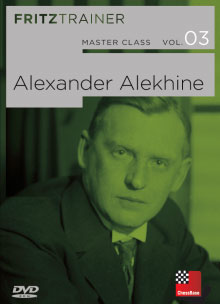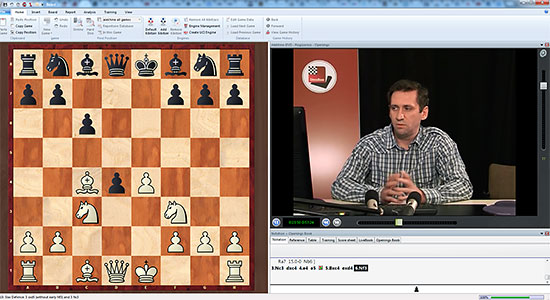 Master Class Vol.3: Alexander Alekhine
Master Class Vol.3: Alexander Alekhine
A review by Moshe Rachmuth
When A. Patzer (that’s me) opened the new Fritztrainer (downloadable) DVD about Alekhine he had two goals. The first goal was to improve his chess and the second was to finally understand how to pronounce the name of the fourth world champion.
Since this was P.’s first time to download from the chessbase store he had to download both the Chessreader 12 and the Alekhine Fritztrainer and install them on his computer. Patzer timed the reader installation at five minutes and the trainer installation at four. That is really neat for a one gigabyte installation. More importantly, all that Patzer had to do during the installations was to press “OK” and “Continue.” A.P. does not like to make decisions during installations. When you come to think of it, A.P. also does not like making decisions on the chess board or in life.
There is one kind of decisions that A.P. likes making, though, and that is the chocolate box decision. You know, when you open a chocolate box and have to decide if you start with the caramel chocolate, the coffee bon-bon or the marzipan delight (some will never eat anything with marzipan but these people I cannot understand and will not oblige to).
Anyway, I mentioned the chocolate box because this is what this Fritztrainer is like only with Alekhine instead of chocolate. You can have Alekhine openings, Alekhine endgames, Alekhine tactics and Alekhine strategy, each coming with a different trainer. Just choose what you like.
Patzer decided to start with the tactics. If there was one thing Alekhine is famous for it is his wild and unexpected moves so why not start with what Alekhine is known for? This is especially true with A.P. who is also known for his unforgetable moves, even if Patzer’s moves are unforgettable in a different way…
The tactics section is led by IM Oliver Reeh. It has 24 interactive mini lectures that are simply awesome. The greatest thing is the interactive nature of the lectures. Reeh talks for about a minute and asks you to suggest a move for Alekhine. You make a suggestion for Alekhine by making a move on the board and then the movie continues with Reeh reacting to your suggestion. For example, when you look at Znosko-Borowsky Vs. Alekhine, 1913, if you make the right move (I will not tell you what it is) Reeh says, “Very well seen…” and explains why it works, while if you make the wrong move Reeh says, “this is a very attractive move but…” and explains why it does not work. I cannot explain how pleasurable it is to hear an IM comment positively on your choice (and there are plenty of questions so you are bound to get a correct one from time to time.)
As for my second goal from the Trainer, Reeh pronounces the name the American way, which is A-Le-Kine.

Portrait of Alexander Alekhine as a young man
Dorian Rogozenco who does the opening part, pronounces the name A-Le-Hin. The openings were the part A.P. was the least interested in for the simple reason that A.P.’s repertoire does not contain the Ruy Lopez, Queen Gambit and other openings that Alekhine played frequently. Even the “systems for one game” that Alekhine played are not part of Patzer’s palette. A.P. usually plays gambits that are so unsound they do not deserve even one game. Having said that, A.P. did watch GM Rogozenco’s video and it was interesting to see the strategic ideas and how Alekhine carried them into the middlegame.
When Rogozenco explains it, the strategy seems so easy – you lock one of your opponent’s pieces on the king side and then you play on the queen side. A couple of small combinations later you are winning. Quite eye opening and in a sense depressing: How have I not been able to carry one long term strategic plan from the opening in all my decades of playing chess? Why does my thought process look mostly like “just don’t drop that rook… Oops, I dropped it.” Maybe Mihail Marin can help me?

Dorian Rogozenco explaining Alekhine's approach to openings
GM Mihail Marin will be your private instructor in the strategy part of the Alekhine Fritztrainer. This part contains five clips (about twenty minutes each) with five classic Alekhine games explained by GM Mihail Marin (if you search for positional guidance for of improving your chess I am sure you have already heard of Marin’s ability as teacher of positional understanding).
Patzer is amazed by what is happening here. Not only is Marin expanding A.P.’s understanding of square complexes, critical squares and the complementing squares between your knight and your bishop but he tells a story of a much grander scale. That Alekhine was a tactical genius is a well-known fact and the reason why A.P. was so interested in the Trainer to begin with. What is less known and the case GM Marin is making is that Alekhine in his own annotations emphasized his tactical ability and downplayed his strategic understanding. Why did he do it?

Alekhine during his first World Championship with Max Euwe
Maybe, says Marin, because Alekhine was a professional chess writer and exhibition giver and he knew sacrifices pleased the audience. By branding himself as an unpredictable player, Alekhine secured himself more invitations and book contracts. Maybe, says Marin there is another agenda. I am going to stop here not to spoil your experience. In any case it is recommended that you watch these clips in order and repeatedly, once to understand the strategic ideas in the games and again to understand the beautiful detective story that Marin builds through the clips. Like Rogozenco, Marin pronounces A-Le-Hin. The one thing I might add to the strategy presentation is a couple of interactive moments, similar to the ones Reeh put in the tactical part. I would be happy to choose between a couple of strategies and see that from time to time I can find the plan Alekhine found.

Mihail Marin
The last video group to be found on the Alekhine Fritztrainer is the one on the endgames, hosted by GM Karsten Müller. If you read anything or watched anything about the endgame in the last twenty years it was probably written or co-written by Müller (who also says A-Le-Hin so that pronunciation of the name wins 3:1 against Reeh’s and my Portland Chess Club colleagues’ A-Le-Kine!) This part contains ten clips of about four minutes each. A.P. will have to watch these again and again for he did not have a great success on guessing Alekhine’s moves. Like the tactics part, the endgame part has moments in which you are asked to guess Alekhine’s moves (and at times the opponent’s move, which is excellent because it gives you the sense that you could also defend an endgame against a world champion, if only you played the correct moves.
After all the monsters have to play chess by the same rules as we, gentle amateurs, do.) Müller has nicely chosen endgames that are in the spirit of Alekhine: endgames where the main feature is the initiative and at times even a checkmate attack with extremely reduced material. There is beauty in such endgames that even P. can appreciate and there is quite some practical stuff here (the Alekhine-Eliskases 1939 is a rook endgame that Patzer promises to remember by heart from this day on – so be warned.) It could have been a bit more elegant if the endgame part was done intrinsically interactive, like it is in the tactical part, rather than have the viewer pause the clip and restart after guessing the move by heart rather than making it on the board. It is more fun to make the move on the board and this is part of what Patzer is here for – the fun, the chocolate, the bonbons.

Alekhine with his beloved cat that he sometimes even had with him when playing.
These four parts (strategy, tactics, openings, endgames) are the main pralines but there are other treats and surprises in the Alekhine Fritztrainer. First there are 102 “Training Questions.” These are positions from Alekhine’s games in which you have to find Alekhine’s next move. Usually there is a hint about what you need to achieve (for example “Mate in 5 moves”) and if you are wrong you get more chances as long as your time does not run out. If you have read so far you know that A.P. loves second chances. After all, I am not really Alekhine and if I find his move on the second try, that’s worth something too, isn’t it?
Another thing you’ll find on the DVD is a good detailed biography by Peter Schreiner with many sources you can go to if you want to read more about Alekhine’s life. A.P. read it briefly: the man was really talented in chess, he moved a lot, many hated him and then he died. That is the problem with biographies. The protagonist dies in the end and is buried. This puts you in a somewhat melancholic mood after reading a biography, a mood that does not suit Patzer who prefers chocolates.
Two more things worth mentioning on the Alekhine Friztrainer are the collection of all of Alekhine’s games and the collections with opening trees. The Collection of all of Alekhine’s games contains 2,327 games many of them with analysis by great annotators such as Alekhine himself, Kotov, Huebner and others: a gold mine for the serious chess student. For those who want to learn the openings of the Russian-French chess legend there is a collection of games in white (725 games) and a collection of games in black (692 games) with a tree. Patzer has no idea how one works with these mysterious trees but that is a question that will be postponed for another day, when we want to concentrate on the openings.
Have we achieved our goals? Has Patzer’s game improved? It definitely did as shows his result on the weekend Swiss he has just participated in (earning some 30 ELO points in four games) and his online results. It’s all in the tactics, as they say and this DVD with its fantastically chosen material and well-crafted presentations will take any player under 2100 to a new level of tactical sight. Viva chocolate boxes! Viva chess fantasy! Viva Alekhine! (and yes, Josh from Portland, Oregon, you should say A-Le-Hin)
Sample video
 |
Master Class Vol.3: Alexander Alekhine
• Video running time: 5 hours (English)
• Interactive tactics test with video feedback
• Collection of all known games Alekhine played, tournament tables, short biography
• Alekhine powerbook: the repertoire of the World Champion as opening tree
• Tactic training: 102 Alekhine games with training questions.
€29.90
€25.13 without VAT (for Customers outside the EU)
$31.06 (without VAT)
This DVD can be purchased as a hard copy or it can be downloaded directly from the Internet.
Order this Fritztrainer in the ChessBase Shop
|


















 Master Class Vol.3: Alexander Alekhine
Master Class Vol.3: Alexander Alekhine









